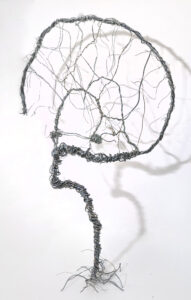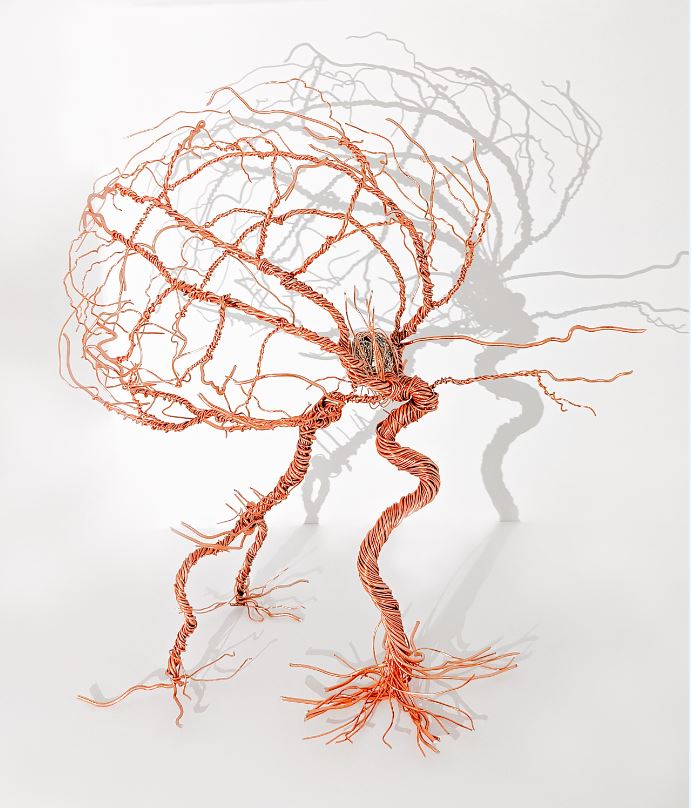As someone who enjoyed creating, building, sculpting and concocting, I often felt at odds with my logical, scientific, organized side. Then, as a first-year PhD student, I saw the beautiful neuronal work of Gregg Dunn, PhD (1) at the Annual Society for Neuroscience meeting. Explosions of Brainbow color and metallic axonal flashes gripped my attention as I walked past exhibitor stalls. It was the first time I had seen art and neuroscience come together in such a way. The first time I realized these two passions were not discordant. I finally had permission to do both.
As I progressed through my MD-PhD training, I often found myself creating, but mostly out of necessity in the lab, or as an educational aid to a scientific-outreach project. The most creative projects were born from a desire to pique the curiosity of those without significant scientific exposure. As someone who grew up right outside of the nation’s capital, in colloquially dubbed “basketball county” (2), I never had the scientific exposure that I craved until college. I recognized the impact one early scientific-engagement opportunity could have. This naturally led me to create more tangible, crafty, visually appealing representations of scientific concepts and demos for future STEMmers.
During my PhD, I would spend my inter-experimental time taping together 3-D cardboard, plastic and construction paper models of the layers of skin, blood vessels and plasma cells; 3D printing brains in the Science Library and upcycling old used scientific posters. These models would go on to be showcased at college football pre-game “STEMzones” (3), on Skype calls to classrooms across the US (4) and in K-12 classrooms (5, 6). Outside of outreach work, I grappled with the best ways to represent my PhD research to scientists and non-scientists alike (7, 8). I found graphic language, visual representations and animations filled the void I was trying to bridge (9). Still, I thought of art and creation as just an educational tool, not something I could learn from or to be enjoyed for the final product.

Then in my fourth year of medical training, I found myself in the neurosurgery angiography suite. From the first moment, I knew I was hooked on the beauty of the cerebrovascular system. As I tried to absorb every detail of the aneurysm coiling procedure from my mentor, Jay Howington, MD, FAANS, FACS (10), I found my brain wandering from the technical aspects to the exquisiteness of the images I was seeing. Every maneuver and manipulation provided new views, planes and orientations of the ICA and branches of the MCA and ACA (11). I was addicted to the elegance and exquisiteness. It looked alien, yet familiar. I had to recapitulate it somehow.
Almost immediately, I knew I wanted to make a wire sculpture. I had not worked with wire since high school art class under the attuned guidance of Ms. Barbara Johnson (12). Still, wire seemed a perfect nod to the vascular neurosurgeon’s toolbox while also having the capacity to closely mirror the tortuosity and intricacies of the cerebrovascular system. I would sit staring at 2D neurovascular illustrations in Osborn’s Diagnostic Cerebral Angiography book and twist, clip and prune for hours in attempts to recapitulate a 3D Circle of Willis (11). Neuroanatomical relationships and angles started to catch me by surprise and enhanced my understanding of the structure. After a few iterations, I crossed the threshold from pure educational creation to something aesthetically appealing, as well.
Initially, I was creating for myself. I wanted to use my hands to intimately learn the turns and twists and idiosyncrasies of the cerebrovascular system. After gifting one sculpture to my vascular neurosurgery mentor, however, his appreciation encouraged me to share the sculpture on a larger scale. I was absolutely astonished at the reception, with a sculpture even earning a spot on the cover of Stroke: Vascular and Interventional Neurology (13). Something that was a casual personal pastime had become something unique and memorable that helped me stand out in interviews and within the community.
Looking back on my early education, it seems comical that I felt pushed to pigeonhole myself into a creative or scientific slot. My love of creation, building and designing led me to create better experiments, models and educational tools in the lab. Those tenets and research experiences led me to realize I enjoyed focused, tactically driven, intricate, detailed work, with room for conversation, problem-solving, education and collegiality. Sound familiar? While my love of creation was realized first, the love of neurosurgery was always there – I just didn’t know it yet. Since then, my neurosurgical experience has reflected me right back to where I began in art class, encouraging creativity and appreciation for anatomical sinewy splendor.
As I prepare to start my residency training, I am excitedly looking forward to the ways my creative hobbies will help me advance in my vascular neurosurgeon-scientist career goals. As I expand on my PhD work in stroke and regenerative medicine, developing therapeutics for those suffering from cerebrovascular disease, I hope to further hone my illustrative scientific communication skills in grants and articles. The real light at the end of the tunnel, however, will be the chance to one day encourage my own lab and neurosurgical team members to bring their personal artistic and alternative hobbies to the table. That is where the real progress will be made.
- Nemo L. Watch the Human Brain Come to Life in This Stunning Piece of Art. 2022.
- Basketball County: In the Water (2020) – IMDb. 2022.
- Cooper C. STEMzone introduces Bulldog Nation to research2019 2019-11-12. Available from: https://news.uga.edu/stemzone-gallery-fall-2019/.
- SKYPE A SCIENTIST. 2022.
- Spellicy S. Pass-it-on Posters 2022 [Available from: https://www.passitonposters.com.
- Betourney C. RBC graduate students take part in STEMapalooza – UGA Today2019 2019-08-09. Available from: https://news.uga.edu/2019-stemapalooza/.
- Spellicy S. Closing the gap between the bench and the bedside: Revolutionizing stroke therapeutics: TED; 2021.
- 2019 3MT Results UGA Graduate School: Graduate School University of Georgia; 2019 [Available from: https://grad.uga.edu/index.php/3mt/2019-3mt-results/.
- Adams C. Samantha Spellicy « The University of Georgia Graduate School UGA Graduate School Magazine: UGA Graduate School; 2020 [Available from: https://gradmag.uga.edu/samantha-spellicy/.
- Howington JU. Commentary: Lessons Learned After 760 Neurointerventions via the Upper Extremity Vasculature: Pearls and Pitfalls. Neurosurgery. 2021;89(1):E73.
- Osborn AG, Jacobs JM. Diagnostic Cerebral Angiography: Lippincott Williams & Wilkins; 1999.
- Barbara Johnson — Art Works Now 2022 [Available from: https://www.artworksnow.org/bj-exec-director.
- Spellicy S. Reflections in Coiling. Stroke: Vascular and Interventional Neurology. 2022;2(1):e000236.








